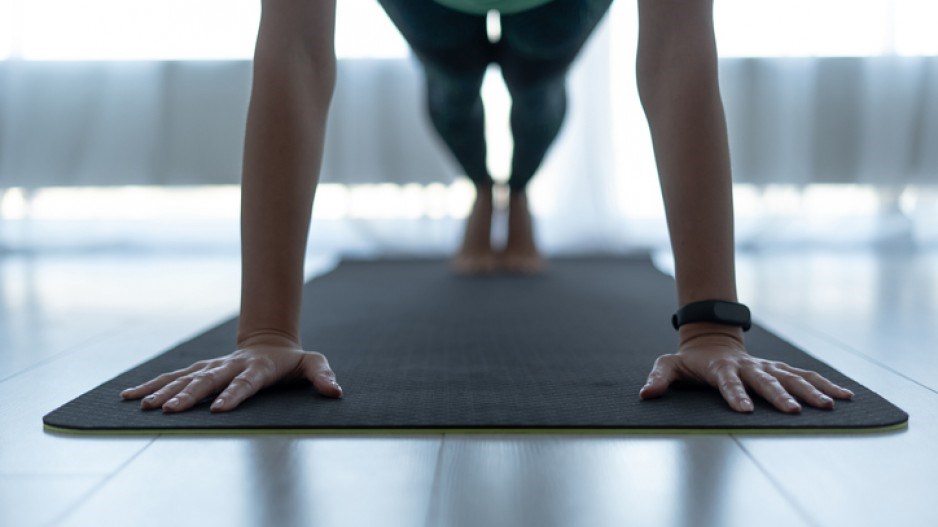In late March, when Canadians were still trying to process the notion of a lengthy lockdown, Research Co. and Glacier Media asked a question about physical activity. At the time, 30% of Canadians said they were exercising at home more often than before the COVID-19 pandemic, including 36% of British Columbians.
Changing our habits is usually difficult. The first days of the lockdown may have motivated Canadians to act differently, but new traits are hard to stick by. By mid-April, some confided about overeating (29%) and drinking too much alcohol (13%) during the pandemic.
Just last week, we talked about the appreciation of millennials for goods baked at home and saw 30% of Canadians acknowledge that they have gained weight during the COVID-19 pandemic. This time, our focus went back to exercise.
The Canadian Physical Activity Guidelines recommend that adults in Canada accumulate at least two and a half hours of moderate- to vigorous-intensity aerobic physical activity per week. Across the country, more than a third of Canadians (36%) told us that they were able to meet this goal “every week” before the COVID-19 pandemic began, while 24% were able to do this “on most weeks.”
Almost two in five Canadians aged 18 to 34 (38%) and aged 35 to 54 (also 38%) claim to have met the desired exercise threshold every week earlier this year, along with 38% of Ontarians, 37% of Albertans and 36% of British Columbians.
What a difference a pandemic makes. With some adults working from home and taking care of children, and many gyms and fitness facilities closed or slowly reopening with limited time slots, the amount of calories burned across the country has dropped significantly. This month, only 29% of Canadians are exercising vigorously for two and a half hours each week, down seven points since the days when COVID-19 did not affect our plans.
The drop in exercise appears in all age groups, with millennials trying their best to maintain their exercise routines every week (34%, down four points). Generation X has been less successful (29%, down seven points). Baby boomers also plunged on this measurement, to 25% from 33%.
British Columbia shows a worrying fluctuation. Before March, only 19% of the province’s residents said they “never” met the desired threshold for vigorous exercise, tied for the lowest number in the country with Alberta. Now, almost three in 10 British Columbians (28%) have given up on exercising, the third highest level in the country after Atlantic Canada (33%) and Quebec (29%). Practically one of every 10 residents of B.C. – usually the fittest province – simply gave up on exercise.
The current state of affairs is forcing people to find new ways to work out. A few weeks, ago, 47% of British Columbians told us they would not go back to the gym without a vaccine for COVID-19 – a proportion that climbed to 54% among women.
In this latest poll, practically half of Canadians (49%) say their exercise routine has been affected by the pandemic. The biggest setback, affecting 33% of residents, is not being able to go to a gym or community centre. This is especially problematic for Canadians aged 18 to 34 (48%), as well as British Columbians and Ontarians (39% each).
There are other components of physical activity that we miss. One in five Canadians (21%) has stopped going to a pool for swimming, and smaller proportions are no longer participating in an organized sports league (15%), going to a yoga studio (13%) or playing pickup sports that are not part of a league (12%).
The confinement has made some Canadians more creative. One in four (25%) is following workouts or routines online, 17% decided to take up a sport that does not require equipment, 12% acquired weightlifting gear and 9% bought a cardio machine for their home, such as an elliptical, treadmill or climber.
The actions of Canadians are not uniform across the country. While 52% of Ontarians have chosen not to do anything new to get their workout fix, the proportion is higher in Alberta (54%), Quebec (56%) and British Columbia (61%).
The country is slowly reopening, with each province specifying the guidelines that will need to be followed to prevent a second wave of infection in the fall. The prospect of a summer with some form of outdoor activities remains alive, but organized sports and pickup games appear to be more of a risk. In any case, some Canadians are showing resilience in trying to recreate their gyms at home and figuring out ways to stay healthy. •
Mario Canseco is the president of Research Co.
Results are based on an online study conducted from June 8 to June 10 among 1,000 adults in Canada. The data has been statistically weighted according to Canadian census figures for age, gender and region in Canada. The margin of error – which measures sample variability – is plus or minus 3.1 percentage points, 19 times out of 20.




